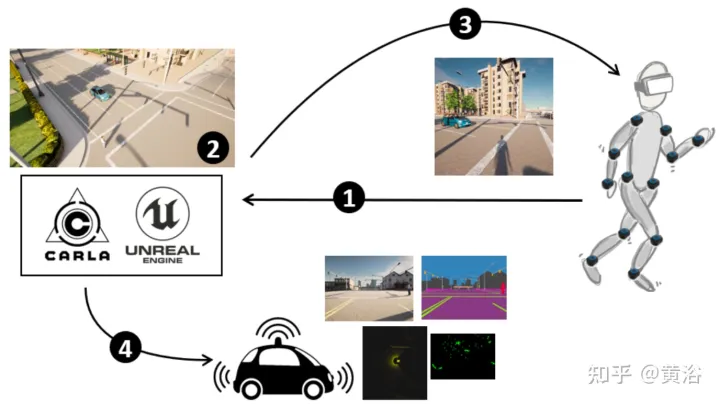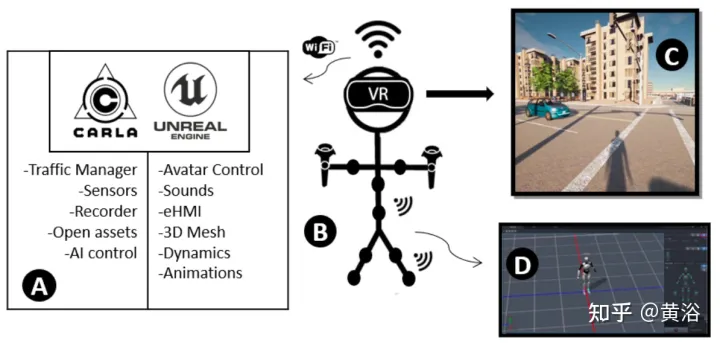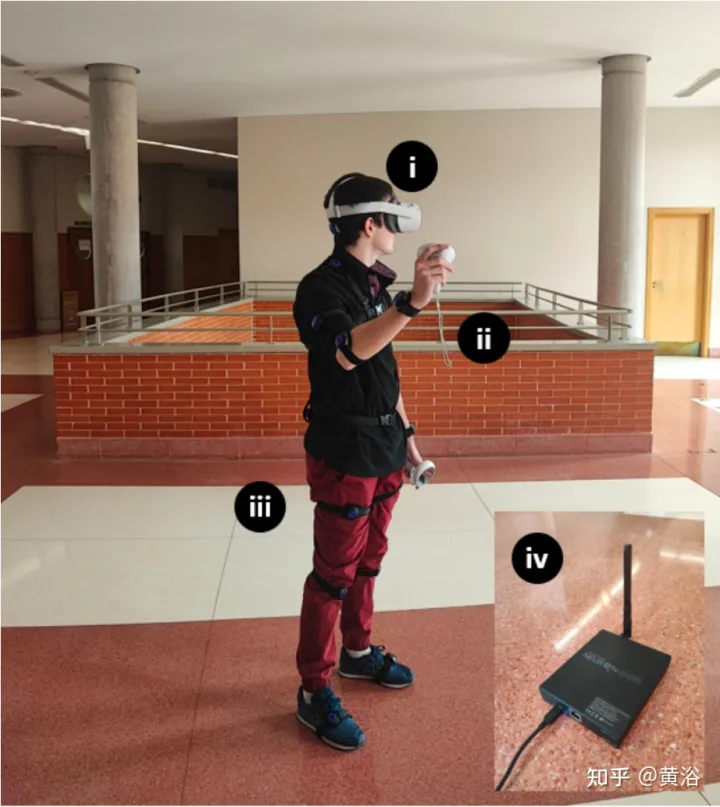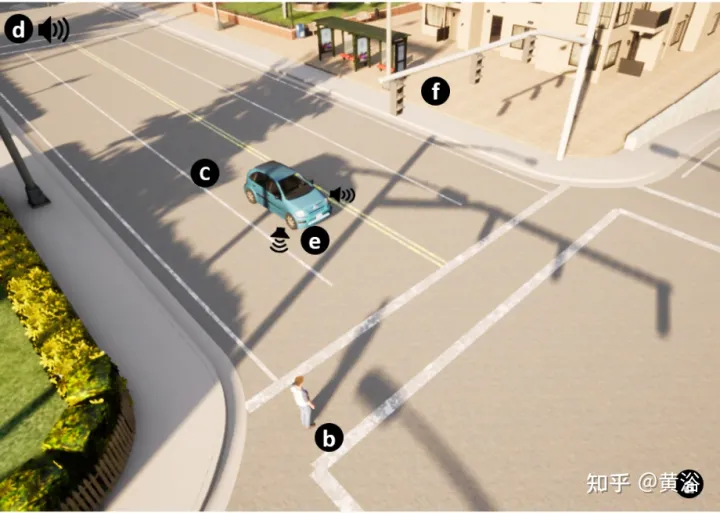Adding real agent behavior to the CARLA autonomous driving simulator
arXiv paper "Insertion of real agents behaviors in CARLA autonomous driving simulator", June 22, Spain.

The role of simulation in autonomous driving is becoming increasingly important due to the need for rapid prototyping and extensive testing. Physics-based simulation offers multiple advantages and benefits at a reasonable cost while eliminating risks to prototyping, drivers and Vulnerable Road Users (VRUs). However, there are two main limitations. First, the well-known reality gap refers to the difference between reality and simulation that prevents simulated autonomous driving experiences from achieving effective real-world performance. Second, there is a lack of empirical knowledge about the behavior of real agents (humans), including back-up drivers or passengers and other road users such as vehicles, pedestrians or cyclists.
Agent simulations are usually pre-programmed, probabilistically random, or generated based on real data, but do not represent the behavior of real agents interacting with specific simulation scenarios. This paper proposes a preliminary framework that enables real-time interaction between real agents and simulated environments, including autonomous vehicles, and generates synthetic sequence data from simulated sensors across multiple views for training predictive systems that rely on behavioral models.
This approach integrates immersive virtual reality (VR) and human motion capture (HMC) systems with CARLA for autonomous driving. It describes the hardware and software architecture and discusses the so-called behavioral gap.
As shown in the figure is an overview of the method: (1) CARLA-UE is equipped with head (VR headset) and body (motion capture system) poses. (2) Generate scenes including autonomous vehicles and digital pedestrians. (3) Provide environment for pedestrians (via VR headsets). (4) Automatic vehicle sensors sense the environment, including pedestrians.
 The following introduces the functions of the immersive VR system in the CARLA autonomous driving simulator.
The following introduces the functions of the immersive VR system in the CARLA autonomous driving simulator.
Achieve full pedestrian immersion by conducting behavioral and interaction studies using the capabilities provided by UE4 and external hardware such as VR glasses and a set of motion sensors.
The CARLA open source simulator is implemented on UE4, which provides high-quality rendering, realistic physics environments and an ecosystem of interoperable plug-ins. CARLA simulates dynamic traffic scenes and provides an interface between the virtual world created by UE4 and the road agent running in the scene. CARLA is designed as a server-client system to achieve this, with the server running the simulation and rendering the scene. Communication between client and server is done through sockets.
 The main characteristics of inserting real agent behavior into the simulation are based on five points (as shown in the figure): 1)
The main characteristics of inserting real agent behavior into the simulation are based on five points (as shown in the figure): 1)
: CARLA blueprint library , collect the architecture of all characters and attributes, modify the pedestrian blueprint, and create an immersive and movable VR interface between people and the virtual world; 2) Body Tracking: Use a set of inertial sensors and proprietary external software Capture subject movement and motion perception through real scenes, and integrate Avatar's movement into the simulator through .bvh files; 3) Sound Design: Since CARLA is an audio-less simulator, positional sounds are introduced in the environment , enhance the sense of immersion; 4) eHMI integration: Realize the communication of autonomous vehicle status and intention information, and do interactive research; 5) Scene simulation: Design traffic scenes in the CARLA client , control the behavior of vehicles and pedestrians. Communication between road users is an important factor in the traffic environment. In the experiment, an external human-machine interface (eHMI) was provided for the autonomous vehicle to communicate its status and intentions to actual road users.
 As shown in the figure, the proposed eHMI design consists of a light strip along the front of the car. The picture on the left is without eHMI, and the picture on the right is with eHMI. This allows studying the impact of the interface on decision-making when pedestrian trajectories converge with vehicle trajectories in virtual scenes.
As shown in the figure, the proposed eHMI design consists of a light strip along the front of the car. The picture on the left is without eHMI, and the picture on the right is with eHMI. This allows studying the impact of the interface on decision-making when pedestrian trajectories converge with vehicle trajectories in virtual scenes.
The entire system architecture is shown in the figure:
 CARLA provides different options to simulate traffic and specific traffic scenarios. Populate simulations with realistic urban traffic conditions with traffic management modules. The control of each vehicle is executed in a specific thread. Communication with other layers is managed through synchronous messaging.
CARLA provides different options to simulate traffic and specific traffic scenarios. Populate simulations with realistic urban traffic conditions with traffic management modules. The control of each vehicle is executed in a specific thread. Communication with other layers is managed through synchronous messaging.
Control traffic flow by setting parameters that force specific behaviors. For example, cars can be allowed to speed, ignore traffic light conditions, ignore pedestrians, or force lane changes.
The main body is integrated into the simulator including a 3-D model map of the city. Each map is based on an OpenDRIVE file describing a fully annotated road layout. This feature allows to design your own maps, reproduce the same traffic scenarios in real and virtual environments, evaluate the integration of the real behavior of the simulator, and be able to conduct field studies by comparing interaction results.
The hardware settings are as shown in the figure: During the experiment, Oculus Quest 2 was used as a head-mounted device (HMD), created by Meta, 6GB RAM processor, two adjustable 1832 x 1920 lenses, 90Hz refresh rate and 256 GB of RAM. The Quest 2 features Wi-Fi 6, Bluetooth 5.1 and USB Type-C connectivity, SteamVR support and 3D speakers. For full-body tracking, package the solution with PNS with an inertial tracker. The kit includes a standalone VR headset, 2 motion controllers, 17 Studio inertial body sensors, 14 sets of straps, a charging case and a Studio transceiver.

Since CARLA build and Quest 2 only rely on Windows, VR Immersion System currently relies on UE4.24 and Windows 10 operating systems. Using the TCP sockets plugin, the editor's position of all participants and other useful parameters are sent from the Python API, integrating each participant's voice or the eHMI of an autonomous vehicle. "VR Preview" starts the game on HMD. Perception Neuron Studio works with Axis Studio, which supports up to 3 subjects at a time and 23 body and finger sensors simultaneously.
The picture shows the simulation of interactive traffic conditions: (a) 3D world design. (b) Pedestrian matching executor Avatar. (c) Self-driving cars. (d) Environmental sounds and intelligent sounds. (e) eHMI. (f) Traffic lights and traffic signs.

The above is the detailed content of Adding real agent behavior to the CARLA autonomous driving simulator. For more information, please follow other related articles on the PHP Chinese website!

Hot AI Tools

Undresser.AI Undress
AI-powered app for creating realistic nude photos

AI Clothes Remover
Online AI tool for removing clothes from photos.

Undress AI Tool
Undress images for free

Clothoff.io
AI clothes remover

AI Hentai Generator
Generate AI Hentai for free.

Hot Article

Hot Tools

Notepad++7.3.1
Easy-to-use and free code editor

SublimeText3 Chinese version
Chinese version, very easy to use

Zend Studio 13.0.1
Powerful PHP integrated development environment

Dreamweaver CS6
Visual web development tools

SublimeText3 Mac version
God-level code editing software (SublimeText3)

Hot Topics
 Why is Gaussian Splatting so popular in autonomous driving that NeRF is starting to be abandoned?
Jan 17, 2024 pm 02:57 PM
Why is Gaussian Splatting so popular in autonomous driving that NeRF is starting to be abandoned?
Jan 17, 2024 pm 02:57 PM
Written above & the author’s personal understanding Three-dimensional Gaussiansplatting (3DGS) is a transformative technology that has emerged in the fields of explicit radiation fields and computer graphics in recent years. This innovative method is characterized by the use of millions of 3D Gaussians, which is very different from the neural radiation field (NeRF) method, which mainly uses an implicit coordinate-based model to map spatial coordinates to pixel values. With its explicit scene representation and differentiable rendering algorithms, 3DGS not only guarantees real-time rendering capabilities, but also introduces an unprecedented level of control and scene editing. This positions 3DGS as a potential game-changer for next-generation 3D reconstruction and representation. To this end, we provide a systematic overview of the latest developments and concerns in the field of 3DGS for the first time.
 How to solve the long tail problem in autonomous driving scenarios?
Jun 02, 2024 pm 02:44 PM
How to solve the long tail problem in autonomous driving scenarios?
Jun 02, 2024 pm 02:44 PM
Yesterday during the interview, I was asked whether I had done any long-tail related questions, so I thought I would give a brief summary. The long-tail problem of autonomous driving refers to edge cases in autonomous vehicles, that is, possible scenarios with a low probability of occurrence. The perceived long-tail problem is one of the main reasons currently limiting the operational design domain of single-vehicle intelligent autonomous vehicles. The underlying architecture and most technical issues of autonomous driving have been solved, and the remaining 5% of long-tail problems have gradually become the key to restricting the development of autonomous driving. These problems include a variety of fragmented scenarios, extreme situations, and unpredictable human behavior. The "long tail" of edge scenarios in autonomous driving refers to edge cases in autonomous vehicles (AVs). Edge cases are possible scenarios with a low probability of occurrence. these rare events
 This article is enough for you to read about autonomous driving and trajectory prediction!
Feb 28, 2024 pm 07:20 PM
This article is enough for you to read about autonomous driving and trajectory prediction!
Feb 28, 2024 pm 07:20 PM
Trajectory prediction plays an important role in autonomous driving. Autonomous driving trajectory prediction refers to predicting the future driving trajectory of the vehicle by analyzing various data during the vehicle's driving process. As the core module of autonomous driving, the quality of trajectory prediction is crucial to downstream planning control. The trajectory prediction task has a rich technology stack and requires familiarity with autonomous driving dynamic/static perception, high-precision maps, lane lines, neural network architecture (CNN&GNN&Transformer) skills, etc. It is very difficult to get started! Many fans hope to get started with trajectory prediction as soon as possible and avoid pitfalls. Today I will take stock of some common problems and introductory learning methods for trajectory prediction! Introductory related knowledge 1. Are the preview papers in order? A: Look at the survey first, p
 Choose camera or lidar? A recent review on achieving robust 3D object detection
Jan 26, 2024 am 11:18 AM
Choose camera or lidar? A recent review on achieving robust 3D object detection
Jan 26, 2024 am 11:18 AM
0.Written in front&& Personal understanding that autonomous driving systems rely on advanced perception, decision-making and control technologies, by using various sensors (such as cameras, lidar, radar, etc.) to perceive the surrounding environment, and using algorithms and models for real-time analysis and decision-making. This enables vehicles to recognize road signs, detect and track other vehicles, predict pedestrian behavior, etc., thereby safely operating and adapting to complex traffic environments. This technology is currently attracting widespread attention and is considered an important development area in the future of transportation. one. But what makes autonomous driving difficult is figuring out how to make the car understand what's going on around it. This requires that the three-dimensional object detection algorithm in the autonomous driving system can accurately perceive and describe objects in the surrounding environment, including their locations,
 Have you really mastered coordinate system conversion? Multi-sensor issues that are inseparable from autonomous driving
Oct 12, 2023 am 11:21 AM
Have you really mastered coordinate system conversion? Multi-sensor issues that are inseparable from autonomous driving
Oct 12, 2023 am 11:21 AM
The first pilot and key article mainly introduces several commonly used coordinate systems in autonomous driving technology, and how to complete the correlation and conversion between them, and finally build a unified environment model. The focus here is to understand the conversion from vehicle to camera rigid body (external parameters), camera to image conversion (internal parameters), and image to pixel unit conversion. The conversion from 3D to 2D will have corresponding distortion, translation, etc. Key points: The vehicle coordinate system and the camera body coordinate system need to be rewritten: the plane coordinate system and the pixel coordinate system. Difficulty: image distortion must be considered. Both de-distortion and distortion addition are compensated on the image plane. 2. Introduction There are four vision systems in total. Coordinate system: pixel plane coordinate system (u, v), image coordinate system (x, y), camera coordinate system () and world coordinate system (). There is a relationship between each coordinate system,
 SIMPL: A simple and efficient multi-agent motion prediction benchmark for autonomous driving
Feb 20, 2024 am 11:48 AM
SIMPL: A simple and efficient multi-agent motion prediction benchmark for autonomous driving
Feb 20, 2024 am 11:48 AM
Original title: SIMPL: ASimpleandEfficientMulti-agentMotionPredictionBaselineforAutonomousDriving Paper link: https://arxiv.org/pdf/2402.02519.pdf Code link: https://github.com/HKUST-Aerial-Robotics/SIMPL Author unit: Hong Kong University of Science and Technology DJI Paper idea: This paper proposes a simple and efficient motion prediction baseline (SIMPL) for autonomous vehicles. Compared with traditional agent-cent
 nuScenes' latest SOTA | SparseAD: Sparse query helps efficient end-to-end autonomous driving!
Apr 17, 2024 pm 06:22 PM
nuScenes' latest SOTA | SparseAD: Sparse query helps efficient end-to-end autonomous driving!
Apr 17, 2024 pm 06:22 PM
Written in front & starting point The end-to-end paradigm uses a unified framework to achieve multi-tasking in autonomous driving systems. Despite the simplicity and clarity of this paradigm, the performance of end-to-end autonomous driving methods on subtasks still lags far behind single-task methods. At the same time, the dense bird's-eye view (BEV) features widely used in previous end-to-end methods make it difficult to scale to more modalities or tasks. A sparse search-centric end-to-end autonomous driving paradigm (SparseAD) is proposed here, in which sparse search fully represents the entire driving scenario, including space, time, and tasks, without any dense BEV representation. Specifically, a unified sparse architecture is designed for task awareness including detection, tracking, and online mapping. In addition, heavy
 Let's talk about end-to-end and next-generation autonomous driving systems, as well as some misunderstandings about end-to-end autonomous driving?
Apr 15, 2024 pm 04:13 PM
Let's talk about end-to-end and next-generation autonomous driving systems, as well as some misunderstandings about end-to-end autonomous driving?
Apr 15, 2024 pm 04:13 PM
In the past month, due to some well-known reasons, I have had very intensive exchanges with various teachers and classmates in the industry. An inevitable topic in the exchange is naturally end-to-end and the popular Tesla FSDV12. I would like to take this opportunity to sort out some of my thoughts and opinions at this moment for your reference and discussion. How to define an end-to-end autonomous driving system, and what problems should be expected to be solved end-to-end? According to the most traditional definition, an end-to-end system refers to a system that inputs raw information from sensors and directly outputs variables of concern to the task. For example, in image recognition, CNN can be called end-to-end compared to the traditional feature extractor + classifier method. In autonomous driving tasks, input data from various sensors (camera/LiDAR






